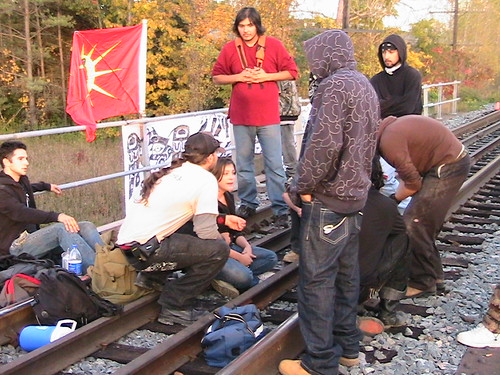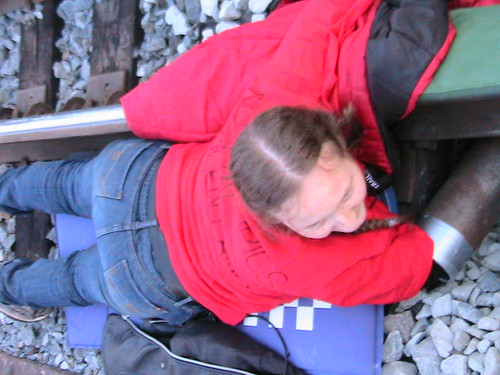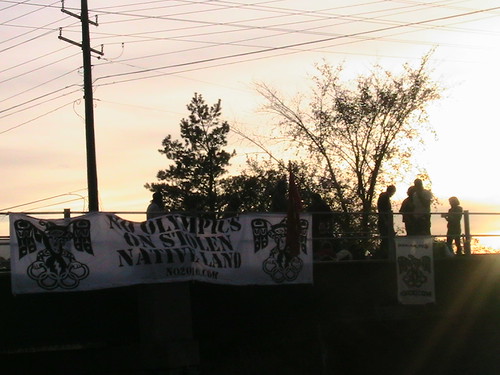DominionSections
Browse Articles
- IndependentMedia.ca
- MostlyWater.org
- Seven Oaks
- BASICS Newsletter
- Siafu
- Briarpatch Magazine
- The Leveller
- Groundwire
- Redwire Magazine
- Canadian Dimension
- CKDU News Collective
- Common Ground
- Shunpiking Magazine
- The Real News
- Our Times
- À babord !
- Blackfly Magazine
- Guerilla News Network
- The Other Side
- The Sunday Independent
- Vive le Canada
- Elements
- ACTivist Magazine
- The Tyee
- TML Daily
- New Socialist
- Relay (Socialist Project)
- Socialist Worker
- Socialist Action
- Rabble.ca
- Straight Goods
- Alternatives Journal
- This Magazine
- Dialogue Magazine
- Orato
- Rebel Youth
- NB Media Co-op
Radio
environment
Toronto, April 26: An examination of the Canadian mining industry

WHAT: 1 day conference about mining issues within Canada and abroad
WHEN: Sunday, April 26, 2009, 10:00am - 7:30pm
WHERE: Earth Sciences, Room 1050 (ES 1050), University of Toronto, 5 Bancroft Avenue
Moderated by Judy Rebick
$10 (sliding scale) to cover cost of meals; free for students. No registration required. Donations gladly accepted (available seating for 400 in auditorium).
Hosts: UTERN, Science for Peace, Students Against Climate Change / Toronto Mining Support Group, Aboriginal Students Association of York University
With the intention of building a movement for change within Canada we are hosting a conference on mining issues at the University of Toronto. This conference will provide the space for people within Canada to interact with affected communities and each other, and the conference format prioritizes facilitating conversations focused on solutions to ending corporate impunity.
“The Question of Sustainability” is a conference dedicated to examining the Canadian mining industry through the lens of sustainability within ecosystems, human rights, culture, and economics.
Featuring speakers from Papua New Guinea, Chile, the Congo, Guatemala, Tanzania and Peru, as well as many First Nations speakers and academics from Canada. This conference brings together indigenous people from the global south and the global north, and serves to address some of the complex social, political and environmental issues that relate to the imposition of extractive industries on traditional cultures.
Major issues include water use and contamination, human rights violations by Canadian companies operating abroad, the question of corporate social responsibility, and the autonomy and preservation of traditional cultures.
» continue reading "Toronto, April 26: An examination of the Canadian mining industry"
Justice Served Cold
Asaf Rashid, one of the four defendants, stands in front of the Nova Scotia Provincial Court. Photo: David Parker
HALIFAX - It was a cold winter's day nearing Christmas, and not much was stirring on the streets of Halifax. In front of the Provincial Court on Spring Garden Road, a group of people huddled together, entering the court for a long-awaited trial date. On December 22, 2008, four Haligonians took the stand and testified in front of a judge to a courtroom packed with supporters.
The defendants had been charged a year and a half earlier after hundreds took to the streets of downtown Halifax on June 15, 2007, to oppose a regional integration proposal known as Atlantica. Charges included carrying weapons, wearing masks with intent, unlawful assembly, and resisting arrest.
The Atlantica demonstrations numbered 400 protesters and included a militant tactic known as a black bloc that intended to shut down the conference.
Demonstrators were targeted by police and reported extreme police brutality, including being choked until unconscious, shocked with taser guns, and beaten by batons.
George Dalli was one of the defendants on trial. "I saw police hitting other people, pepper spraying, tasers were drawn: it was an intense and intimidating situation before the arrest. I told the officers 'I'm not resisting arrest, not trying to be violent.' I was rolled onto my stomach, hands behind my back. I was choked, fingers were jabbed into my neck, I said 'don't do this to me, I'm losing consciousness, don't do this to me', and I continued saying this until I lost consciousness."
The 21 individuals arrested that day spent the next three days in jail, the first 48 hours in lockdown.
110-Year Rush
Songs moved to survive the goldrush are returned to the Tr’ondëk Hwëch’in
PHOTO: Solidarity Blockade Slows Spirit Train
By Lia Tarachansky and Jesse Freeston
Vaughan, ON- On Thanksgiving Sunday, October 12th, 2008 roughly two dozen protesters blockaded the Canadian Pacific Rail just north of Toronto.
The blockade began at 5:30 p.m. and ended just after 8:00 p.m. Winnie Small, 20, attached herself to the rails in order to delay removal by police.
Alex Hundert, police liaison for the varied group of protesters, negotiated with the local police service, which was taken by surprise by the bridge blockade.
The group, consisting of Anti-War @ Laurier organizers, native organizers from the Six Nations reservation by Caledonia, and various individuals, was allowed to leave the blockade without arrests or conflict.
According to the police, who were in communications with CP rail on site, the blockade caused millions of dollars of economic damage and delayed trains all along the rail line.
Please stay tuned for The Real News Network video report later this week

Blockaders Set up lock down

Winnie Small, 20, locked down to the tracks with a "v" shaped metal bar

"No Olympics on Stolen Native Land" banner laid out by protesters

» continue reading "PHOTO: Solidarity Blockade Slows Spirit Train"
Golden Opportunity: Mining Against All Costs
Originally published in the Canadian Dimension magazine, September/October 2008 issue
Guided by resource discovery and the heavy-handed rule of the free market, the mining of gold today is “rush-mining,” much as it was a century ago. From the Indigenous lands of Brazil to those in Canada, from Tanzania to the Philippines, whenever gold is discovered, local communities are forced to migrate or attempt to adjust to the new industry. In fact, only eleven per cent of the gold mined worldwide has a practical use in technologies like biomedicine or electronics. Meanwhile, seventy per cent is used for jewellery, with the rest going to investment. Some 35,000 tonnes of gold simply sit in bank vaults around the world, while the environment and innumerable communities are destroyed for its excavation.
Canada plays a huge role in this global market, being home to the largest gold-mining corporations in the world. At the very top reigns Barrick Gold, with others like Goldcorp, Gabriel and Pacific Rim close behind. Collectively they mine on every continent except Antarctica, on which mining is forbidden. But not all gold is excavated by large, corporate colonialists, nor is all of it done abroad. One quarter comes from artisanal or small-scale mining, and minimal but continuous extraction takes place at home (mostly in Ontario and Quebec.)
Countries in Central America and Central Africa have low environmental regulations and worker-safety requirements. They are resource-rich, and are therefore a lucrative destination for Canadian businesses. At home, even though most resource extraction takes place on Indigenous lands, we have relatively strict extraction, land-use and environmental laws, meaning most companies strive to mine offshore.
» continue reading "Golden Opportunity: Mining Against All Costs"
Notes from the Tar Pits: Flying Above an Open Pit Graveyard
Notes from the Tar Pits:
Flying Above an Open Pit Graveyard
Macdonald Stainsby // June 15, 2007
The plane cleared the tarmac and into the air we went, with a warning that the flight was going to have to go a little bit to the east of the usual, as the forest fires were too heavy. But the plume of white obfuscation that rose more than all the others was Suncor’s, with 2nd through 6th place going to Syncrude, CNRL, Albian/Shell, Total and (off in the distance) Petro Canada. It was completely impossible to spot any difference between the forest fires and the plumes of death-toxins breaking up into the atmosphere.
The giant tailings lakes are a sight to behold. The one near Syncrude, as I discovered from our pilot, is among the largest human made dams in the entire world. Though, I’m getting “biggest” fatigue; Every time I learn a new angle on how this is operating, it’s about the “biggest”. As a gentleman who drove us out of Fort MacKay said the other day: “If it’s the biggest in the world, it’s here,” and he was making zero reference to anything in particular.
Along with the largest craters in the world, deep pits of black sided land, being munched away, 24 hours a day, 7 days a week and through every holiday are the highways being constructed. While people living downstream in Fort Chipewyan have unsafe running water in their homes and are a seasonal fly-in community, the roads to “projects” are as relentlessly constructed as the tar is pulled out of the earth. There are full private highways, and when it’s time to pull the tar from under the highway, they simply move it and build another one. Oil is still oil, after all (even when it is tar and synthetic/mock).
» continue reading "Notes from the Tar Pits: Flying Above an Open Pit Graveyard"
The ultimate thermodynamic fate of all closed systems
Counterpunch has good pieces about similar dynamics in two different US political movements, environmentalism and anti-war.
Jeffrey St. Clair on the green movement's disconnection from the grassroots, and the unfortunate accuracy of right wing claims that environmentalists are Washington elitists:
To quote Jospeh Heller: Something happened. Somewhere along the line, the environmental movement disconnected with the people, rejected its political roots, pulled the plug on its vibrant and militant tradition. It packed its bags, starched its shirts and jetted to DC, where it became what it once despised: a risk-aversive, depersonalized, hyper-analytical, humorless, access-driven, intolerant, centralized, technocratic, dealmaking, passionless, direct-mailing, lawyer-laden monolith to mediocrity. A monolith with feet of clay.
» continue reading "The ultimate thermodynamic fate of all closed systems"
All's quiet on the tar sand front...
Peter Cizek explains why: Scouring Scum and Tar from the Bottom of the Pit.
An indepth look at the "gigaprojects" rocking the North, and the web of NGOs tied up in corporate/ money who thus far have largely failed to respond to what Cizek calls an "environmental holocaust."
Archived Site
All Topics
The Dominion is a monthly paper published by an incipient network of independent journalists in Canada. It aims to provide accurate, critical coverage that is accountable to its readers and the subjects it tackles. Taking its name from Canada's official status as both a colony and a colonial force, the Dominion examines politics, culture and daily life with a view to understanding the exercise of power.



